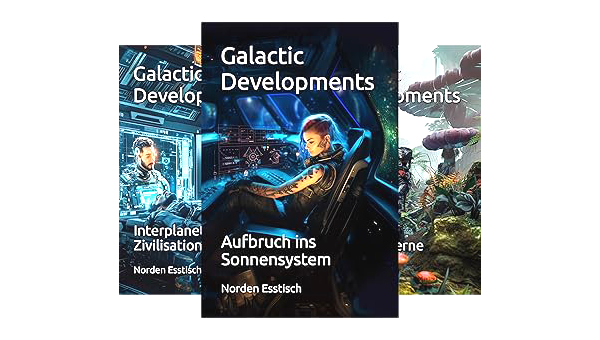
2128 Der beliebte Kinder Gen-Baukasten "Darwin"

Darwin von Jogos Ubirajara ist der erste Gen-Baukasten, der die Herstellung künstlicher Lebensformen auf spielerische Weise abbildet. Die Zielgruppe sind Jugendliche zwischen 14 und 17 Jahren.
Der Baukasten enthält einen intuitiven Gen-Designer mit HUD-Schnittstelle. Der Designer dient dazu, Organismen zusammenstellen. Die Grundform ist ein Omnipod, eine vollständig künstliche Lebensform. Der hier verwendete Omnipod ist eine angepasste, vereinfachte Variante der weit verbreiteten H8Z2(b)-Linie, der Standardplattform unzähliger wissenschaftlicher Experimente.
Im Gen-Designer wählt und kombiniert man die gewünschten Eigenschaften. Eine große Bibliothek von vorgefertigten genetischen Merkmalen steht dafür zur Verfügung. Der Designer wird über Neuroimplantate (Nimps) bedient. Da viele Kinder erst nach der Pubertät ihre Nimps bekommen, lässt sich der Designer auch mit VR-Brille und sogar per Panorama-Tapete bedienen.
Ist das Design abgeschlossen, dann kann der Organismus hergestellt werden. Ein Chromosom-Drucker synthetisiert die DNA. Der Drucker braucht dafür typischerweise ein paar Stunden. Er kommentiert den Fortschritt mit lehrreichen Animationssequenzen. Dabei erfährt man welche Gene und Eigenschaften gerade gebaut werden. Man kann so den Entstehungsprozess im Detail verfolgen. Der Drucker kapselt schließlich das fertige Genom in eine künstliche Zellkernhülle.
Per virtuellem Drag-and-Drop übergibt die Benutzerin den Kern dann aktiv an die Wachstumseinheit, den sogenannten Crescer. Dort wächst aus der ersten Zelle der Organismus heran. Der Crescer ist ein vollautomatisches Wachstumssystem mit allen notwendigen Ernährungs-, Reinigungs-, und Kontrollfunktionen. Im Starterset enthalten ist Wetware für zehn Läufe: zehn neutrale Basiszellen und zehn Einmal-Wombs (Softkokons mit biologischem Adapter zum Crescer) mit je 20 ml Kapazität.
Zwei Liter beigefügte Nährlösung mit allen proteinogenen Aminosäuren reichen dank der patentierten Recyclingtechnik des Wachstumssystems für bis zu 200 Gramm Lebensformen. Die Verbrauchsgüter lassen sich leicht nachbestellen. Der integrierte Monitor ordert rechtzeitig neues Material. Ein Refill-Abo wird empfohlen, um ungebremsten Spielspaß zu gewährleisten.
Mit dem Aufbaukasten "Sequenzierer" kann man das Genom von Lebensformen analysieren und deren Gene der eigenen Bibliothek hinzufügen. Zum Beispiel lassen sich die Gene von Hautpigmenten aus vielen Pflanzen gewinnen. Die Kombination von Genen aus verschiedenen Quellen erfordert einige Übung, da Gene miteinander interagieren. Eine zusätzliche Simulator-Software als Addon kann da helfen. Der Simulator spart Fehlversuche, die nur unnötig Material verbrauchen, aber nicht lebensfähig sind.
Für Fortgeschrittene gibt es einen Protein-Designer mit dem man gezielt funktionale Gruppen erstellen kann. Die Kernkomponente ist ein integrierter Protein-Folder, der auch im Profi-Bereich eingesetzt wird.
Neben dem Omnipod stehen andere Plattformen als Upgrade zur Verfügung. Jede Plattform kommt mit einer eigenen Merkmalsbibliothek. Jogos Ubirajara legt sehr großen Wert auf eine gute Abstimmung zwischen Plattform und Merkmalsbibliothek und auf die uneingeschränkte Kombinierbarkeit der Merkmale.
Mit Sequenzierer und Protein-Designer kann man neue Merkmale entwerfen und veröffentlichen. Schon nach kurzer Zeit sind hunderte neue Merkmale im Umlauf. Zum Teil werden sogar wissenschaftliche und kommerzielle Genvorlagen für die "Darwin" Plattformen adaptiert. Natürlich kann man auch komplette Designs, Gen-Templates bestehend aus funktional abgestimmten Merkmalen herunterladen und ausprobieren.
Manche Designs haben praktische Anwendungen, wie das "Flusenpod"-Template, aus dem ein kleines eiförmiges Wesen entsteht, das auf vier Stummelbeinen läuft, unermüdlich Staub in der Wohnung einsammelt und von der Darwin-Nährlösung lebt. Den passenden Nährlösungsspender kann jeder handelsübliche Drucker herstellen.
Ein bemerkenswertes Design ist der Meerk4t-Flyer. Ein flugfähiges Wesen, das über einer bestimmten Stelle kreist und einen Pfiff abgibt, wenn sich ein anderer Mensch nähert. Für so komplexe Funktionen braucht man allerdings das ZNS-Level-3 Upgrade für den Crescer und 100 ml Wombs.
Der CGC (Chaos Gene Club) zeigt wie man Darwin hacken kann. Die Tüftler verwenden Darwin, um biometrische Verifikation zu täuschen. Sie sequenzieren eigene (oder fremde) menschliche DNA und stellen daraus DNA-treue Fingerabrücke her. Fingerabdrücke, die nicht nur das richtige Muster aufweisen, sondern auch DNA-Flashtests standhalten (Template "Goldfinger"). Mit einigem Aufwand ist es sogar möglich, künstliche Augen herzustellen, die Retina-Muster für Zugangskontrollen perfekt imitieren.
Mehr Kultur
2078 Neueste Forschung
2090 Adaptive Zusammenfassung
2115 Neuroimplantate
2128 Kinder Gen-Baukasten
2165 Yksityiskohta World Jam
2168 Spaceship Udyama
2231 Vereinte Planeten
2234 Am Ende des Orbits
2326 Kein interplanetarer Krieg
2343 0G-Spiele
2369 Mabesi-Krise
2445 Scum-Festival
2625 Alien-Tiere kommen zu uns
2664 Die Geschichte der Galaxis
2693 Reisen unter fremden Sonnen
2721 Spacedom-Tragödie
2750 VR-Drama Executive Decision
3050 Königliche Garde
3090 Solo Ehre
3131 Roboter und Drachen
3300 Begriffsveränderung
3353 Tor der Kontroverse
Neue Beiträge
2158 Space Patrol
2222 Weltraumpiraten
2326 Kein interplanetarer Krieg
3050 Königliche Garde
3090 Solo Ehre
2234 Am Ende des Orbits
2248 Gemini-Katastrophe
2366 Orbitale Ökonomie
2312 Kaio-Artefakt
3361 Erste Menschheit
2333 Metrische Impulsverstärkung
2337 Verschwörung im Orbit
2247 Quantensprung
2284 Trennung der Erde
2321 Isolation der Erde
2205 Unternehmensnationen
2192 Antiexpansionistischer Terror
2179 Private Asteroidenbasis
2231 Vereinte Planeten
2291 Verbotene Forschung
Die Besten
(20 von 75)
2234 Am Ende des Orbits
2248 Gemini-Katastrophe
2265 Öko-Militarismus
2291 Verbotene Forschung
2303 Raumhändler-Putsch
2337 Verschwörung im Orbit
2471 Krieg auf der Venus
2518 Geheime interstellare Mission
2544 Nachricht des Jahrhunderts
2648 Abenteuerliche Reise
2746 Medizinischer Durchbruch
2844 Digitale Entdeckung
2956 Chaosmanager
3090 Solo Ehre
3110 Zersplitterung des äußeren Systems
3116 Shackleton-Aufstand
3131 Roboter und Drachen
3225 Flux-Manifest
3308 Supernova
3361 Erste Menschheit
 2115
Neuroimplantate
2115
Neuroimplantate

 2135
Sonnenschirm für die Erde
2135
Sonnenschirm für die Erde